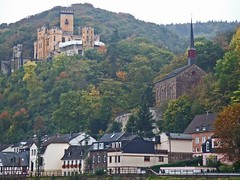Rembrandt: his last name, van Rijn, means "on the Rhine"
The Rhine -
German: Rhein;
Dutch: Rijn;
French: Rhin;
Romansh: Rain;
Italian: Reno;
Latin: Rhenus
West Frisian Ryn -
is one of the longest and most important rivers in Europe, at 820 mi.
The name of the Rhine derives from Gaulish Renos, and ultimately from the Proto-Indo-European root *reie- ("to move, flow, run"), which is also the root of words like river and run.[2] The Reno River in Italy shares the same etymology. The spelling with -h- seems to be borrowed from the Greek form of the name, Rhenos,[2] seen also in rheos, stream, and rhein, to flow.
The Rhine and the Danube formed most of the northern inland frontier of the Roman Empire and, since those days, the Rhine has been a vital, navigable waterway, and carried trade and goods deep inland.
The many castles and prehistoric fortifications along the Rhine testify to its importance as a waterway. River traffic could be stopped at these locations, usually for the purpose of collecting tolls, by the state that controlled that portion of the river.
The most notable wines from the Rhine valley: Riesling - fragrant dry or sweet white wine from the Rhine valley or a similar wine from California, and liebfraumilch - a sweetened Rhenish wine (especially one from Hesse in western Germany).
Due to the relief, the Rhine flows from Switzerland north to the Netherlands. The mouth of the Rhine is at Rotterdam.
Cities through which the Rhine flows:
Basel, Strasbourg, Mannheim, Wiesbaden, Mainz, Koblenz, Bonn, Cologne, Düsseldorf, Utrecht (Kromme Rijn) and Rotterdam (Nieuwe Maas).
Thursday, February 4, 2010
Subscribe to:
Post Comments (Atom)





No comments:
Post a Comment